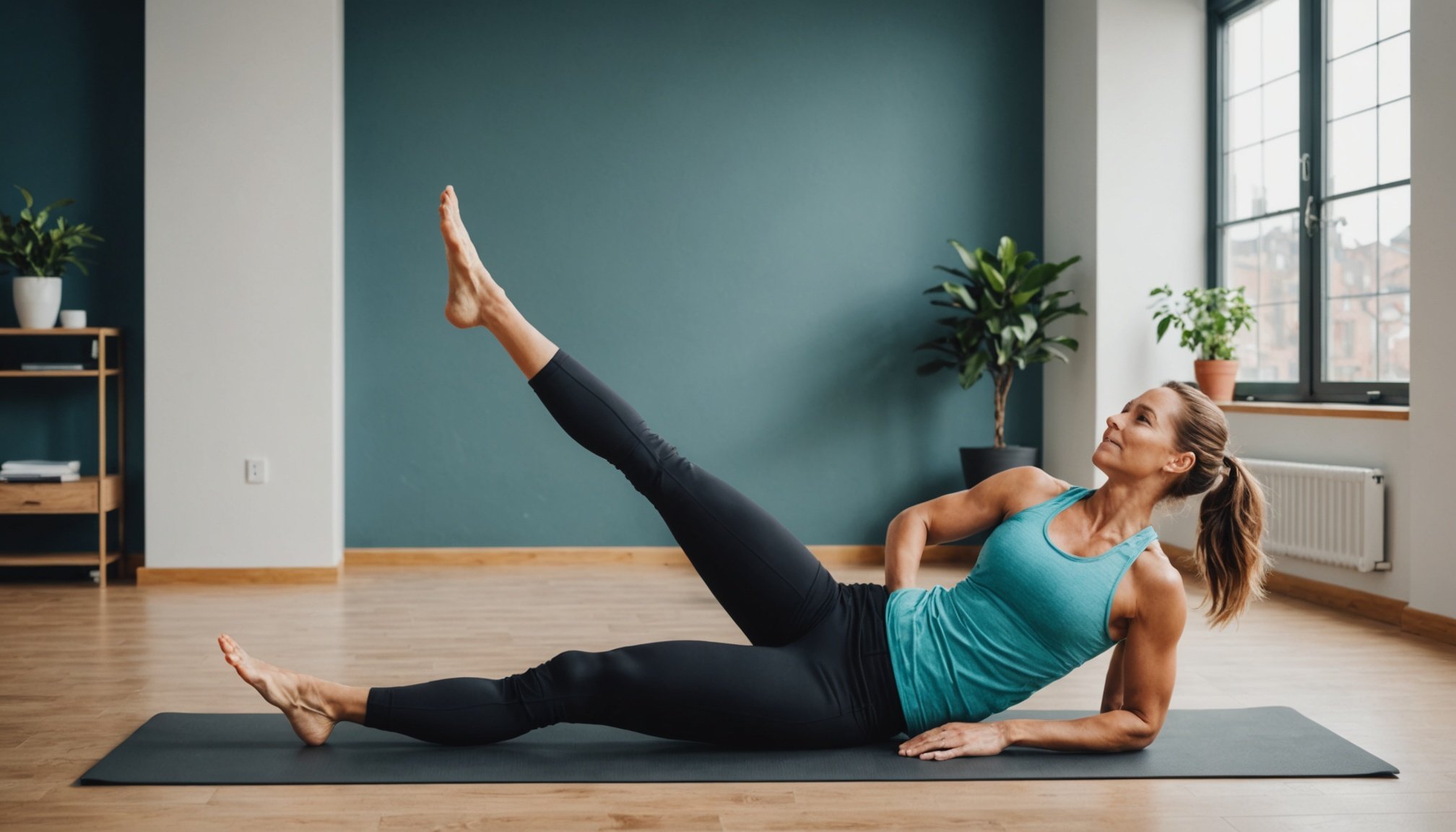Understanding Sciatica and Core Strength
Sciatica involves pain along the sciatic nerve, often felt in the lower back, buttocks, and legs. Symptoms can include tingling, numbness, and sharp pain. Many people find it quite debilitating, as it affects daily activities and overall quality of life. Addressing this discomfort, therefore, becomes crucial.
Core strength plays a pivotal role in alleviating sciatic pain. A strong core helps support the spine, offering stability and reducing strain on the sciatic nerve. Through strengthening abdominal and back muscles, the body achieves better alignment and posture, ultimately minimizing pain.
Also read : Transforming Lives: Effective Strategies to Enhance Well-Being for Chronic Illness Patients
Pilates is particularly effective in enhancing core strength and flexibility. It focuses on controlled movements and emphasizes breathing, balance, and coordination. By integrating Pilates into a fitness routine, individuals can gradually build the core strength necessary to support their lower back, providing relief from sciatica. Additionally, Pilates enhances muscular flexibility, further contributing to long-term pain relief and prevention.
Incorporating Pilates into one’s lifestyle not only addresses the immediate discomfort of sciatica but also encourages sustained core development and improved physical health. Thus, understanding the connection between core strength and sciatica, and recognising the benefits of Pilates, can greatly improve one’s approach to managing sciatic pain effectively.
Topic to read : How having a pet dog can alleviate anxiety disorders in children: a deep dive into the benefits of canine companionship
The Benefits of Pilates for Sciatica Relief
Sciatica relief can often feel elusive, but Pilates benefits offer a promising solution. Let’s delve into this fitness form’s potential to alleviate sciatica discomfort by strengthening and supporting the body’s core.
Strengthening Core Muscles
Core muscles act as a support system for your spine. Certain Pilates exercises, such as Planks or Leg Lifts, specifically target these muscles. By enhancing core strength, Pilates reduces the strain and pressure on the sciatic nerve. What’s more, individuals can track progress through improved endurance and reduced pain over time.
Enhancing Flexibility
Flexibility plays a crucial role in relieving sciatica symptoms. Regular Pilates practice includes stretches like Spine Twists, targeting the lower back and hips. These exercises not only alleviate sciatica pain by loosening tight muscles but also offer long-term flexibility benefits, ensuring a wider range of motion.
Promoting Better Posture
Bad posture can exacerbate sciatica discomfort. Pilates benefits include exercises that promote spinal alignment, such as the Roll-Up. By improving posture, Pilates can lessen the impact on the sciatic nerve, providing significant relief. Overall, a consistent practice can foster realignment and offer lasting, holistic wellness.
Effective Pilates Exercises for Sciatica
For those living with sciatica, integrating specific Pilates exercises can provide substantial relief. These exercises target areas crucial for pain mitigation and support. When it comes to alleviating pain, precision in exercise selection is vital.
Recommended Exercises for Sciatica
- The Pelvic Tilt: Helpful in relieving back tension and improving alignment.
- Knee to Chest: Targets the lower back, providing a gentle stretch.
- Spine Stretch: Enhances flexibility along the spine, reducing pressure on the sciatic nerve.
These exercises are designed with different skill and pain levels in mind. Beginners might start with modified versions to ensure comfort, while more advanced practitioners can gradually increase difficulty as their core strength builds.
Proper form is crucial to preventing injury. Performing exercises mindfully ensures that the targeted core muscles are engaged effectively, facilitating a protective mechanism for the spine. Pilates, when practiced consistently, not only offers immediate pain relief but also contributes to long-term management of sciatica. Over time, dedicated practitioners can witness an improvement in their pain management and overall mobility, reflecting the true potential of Pilates as a holistic approach to wellness.
Incorporating Pilates into Your Routine
Adding Pilates to your daily routine offers numerous benefits in improving core strength and managing sciatica. Consistency is key for achieving optimal results, as it ensures continuous progress and builds enduring strength. Integrating this practice regularly also assists in habit formation, turning it into a seamless part of your lifestyle.
Scheduling Your Workouts
Creating a sustainable Pilates schedule is crucial. Start by determining a frequency that suits your lifestyle, such as three times a week, and gradually increase as you become more comfortable. Consistent practice is essential to experience the full benefits of Pilates, including lasting sciatica relief. Balance Pilates with other fitness activities for a holistic approach to wellness.
Finding a Class or Instructor
Attending classes offers guided instruction, helping ensure exercises are performed correctly, maximising effectiveness and minimising injury risk. A qualified Pilates instructor can tailor routines to accommodate your skill and pain levels. For home practice, explore online resources that offer varied classes, allowing flexibility and convenience.
Tracking Progress and Adjustments
Monitoring improvement in core strength and pain relief is vital. Adjust exercise intensity or frequency based on your progress, and celebrate milestones to maintain motivation. Regularly evaluating your progress can provide insights into how Pilates impacts your physical and mental health, fostering a positive journey towards holistic wellness.
Psychological and Physical Benefits of Pilates
Pilates offers numerous mental benefits alongside physical improvement, making it a holistic wellness solution. This practice is not solely about building physical health; it also supports mental well-being by promoting relaxation and stress reduction. Engaging in Pilates regularly can help individuals manage pain through the mindful aspects of breathing and concentration, which are integral to this fitness form.
Connection Between Physical Fitness and Mental Health
There is a strong connection between maintaining physical health and improving mental wellness. Pilates enhances this connection by creating an environment for self-care and mindfulness. With its emphasis on controlled movements and body awareness, Pilates helps cultivate a balanced mindset, fostering a sense of accomplishment and positivity through measured progress.
Holistic Approach to Wellness
Adopting Pilates as part of a daily routine offers a comprehensive approach to both physical and mental wellness. Practicing consistently aids in managing stress effectively while boosting strength, flexibility, and posture. This well-rounded method encourages personal growth, reinforcing the harmony between the body and the mind.
By incorporating Pilates into their lives, individuals tend to experience a transformation that boosts their overall quality of life, addressing both physical ailments and mental relaxation needs.
Personal Testimonials and Success Stories
Engaging with individual success stories sheds light on the transformative power of Pilates for managing sciatica. These testimonials offer encouraging insights into real-life experiences and the tangible improvements people have made through consistent practice.
One common thread in these experiences is the impactful role of Pilates in enhancing core strength. For instance, many individuals report significant reductions in pain after incorporating targeted exercises into their routines. They often attribute these improvements to a strengthened core, which effectively supports the spine and reduces pressure on the sciatic nerve.
In several testimonials, individuals highlight the newfound flexibility they achieve. Such progress often leads to increased mobility and improved posture, which further alleviates sciatic discomfort. Importantly, these exercises also foster a sense of accomplishment and confidence, reinforcing their commitment to a holistic wellness regimen.
Sharing these real-life stories fosters a sense of community support, providing motivation and encouragement for others embarking on their Pilates journey. These narratives underscore the potential for meaningful change, affirming that with dedication and the right guidance, Pilates can evolve into a vital component of a comprehensive approach to managing sciatica effectively.











